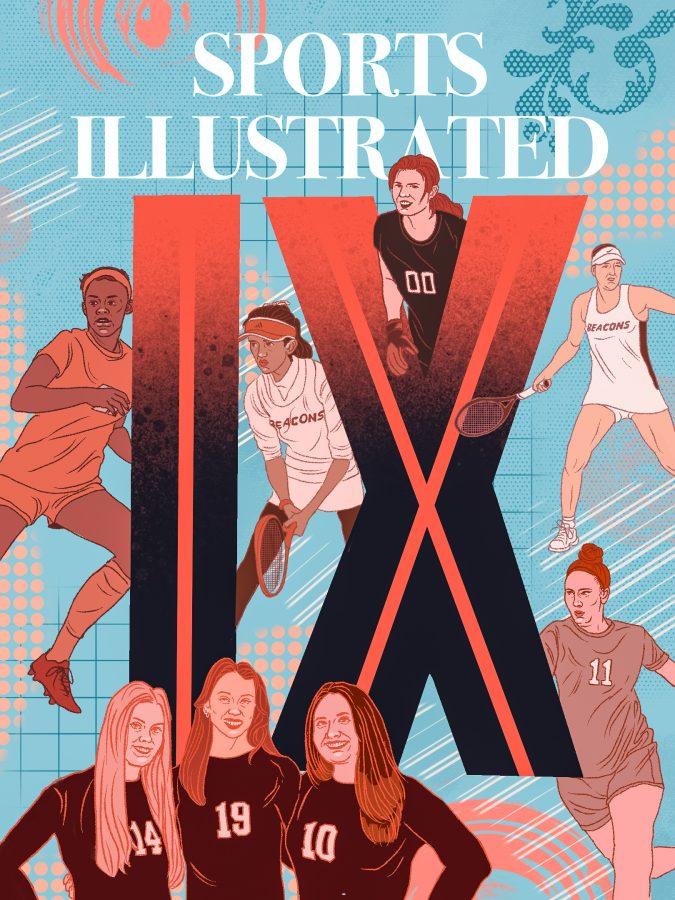UMass Boston LEC athletes with a Sports Illustrated magazine-style background.
The year 2022 marks the 50-year anniversary for the passing of Title Nine, often noted by the Roman numeral IX.
Title IX is a federal civil rights law part of the Education Amendments Act of 1972. The amendments specify guidelines for the federal money awarded to educational institutions (1).
The law clarifies that “No person in the United States shall, on the basis of sex, be excluded from participation in, be denied the benefits of, or be subjected to discrimination under any education program or activity receiving federal financial assistance.”
This means that if an institution is receiving funding from the government—which is often the case, even for private institutions—they must ensure that all of the programs provided are equitable for all genders. The federal financial assistance often comes in the form of the federal financial aid used by the students.
The legislation faced resistance by people who, at the time, said that it was unimportant. However, it was the first-time sex was mentioned in the Education Acts so was sustained and in March of 1972 it was passed. On June 23, 1972, it was ratified by the United States, officially becoming a law.
Title IX was created by Birch Bayh, who served in the U.S. Senate as a representative for Indiana from 1963-1981 (2). Bayh also authored the 25th and 26th amendments of the Constitution, and created reforms that affected the patent, and the juvenile prison system (3). Although, when he reflected on his career at the age of 91, before his death in 2019, the work he was most proud of was generating Title IX.
The Indiana senator credits his wife at the time, Marvella Hern, for inspiring him to design the legislation. He also stated that Hern taught him what it was really like to be a woman in a man’s world. Without her, he knew he wouldn’t understand the importance of the act and the effects of it on people across the country.
She talked about the limited opportunities and discrimination women faced in education, which later translated to limited opportunities in the workforce that were usually lower level jobs. Therefore, she believed that funding education equally would benefit the labor market.
The amendment reaches every aspect of education, including course offerings, counseling and financial assistance, not to mention student health and insurance, housing, athletics and employment.
Nevertheless, in today’s world, mentioning Title IX is almost synonymous with mentioning athletics. Why is that? Before this amendment, women rarely had opportunities to practice sports, nor have their own teams within universities. However, with this amendment, women were given more opportunities to play and compete.
This did not mean that every sport in every university immediately had a women’s team. It meant that if women in a particular university were interested in participating in athletics, they had a path in establishing a team.
Even today, women everywhere are using this legislation to create new teams in universities. For example, the NCAA highlights Kelsey Koelzer. Koelzer played women’s ice hockey for Princeton University as an undergraduate, but her passion for the sport pushed her to spread the sport and start a team at Arcadia University in Glenside, PA. (4).
Another aspect that was required to change were scholarships and recruitment, as the law ensured that the money awarded to student-athletes is proportional to their participation. Proportionality is a big aspect of equality since it is a response to student interests and abilities.
In this way, Title IX ensures access to locker rooms, practice facilities, equipment, coaching and other training services to meet the needs presented by the athletes.
Other ways Title IX considers equality is by ensuring prime time is shared at the time of scheduling games. The UMass Boston community can see an example of this in UMass Boston’s athletics when a team such as men’s hockey may be playing an away game around 7 p.m., while women’s hockey uses Edward T. Barry Ice Rink at home.
Overall, the philosophical underpinning is that there cannot be an economic justification for discrimination. The NCAA notes that they must “demonstrate a history and continuing practice of program expansion for the underrepresented sex,” (1). UMass Boston added women’s hockey during the 2003-04 year and is looking forward to adding women’s lacrosse during the 2024-2025 school year (6).
Similarly, under Title IX regulations, every college must designate at least one employee as a coordinator. At UMass Boston, the Director of the Office of Civil Rights and Title IX Coordinator is Anne-Valerie Imparato (5).
In addition, the highest leadership position at UMass Boston was recently occupied by a woman. Jacqueline Schuman, Ed.D. is the current Director of Athletics and Recreation. Schuman was appointed by Chancellor Marcelo Suárez-Orozco during the summer of last year and assumed the role on July 19, 2021. Previously, she was the Senior Associate Athletic Director at Colby College (7). On June 23, the day of the legislation’s anniversary, Dr. Schuman wrote a piece about the importance of Title IX, accessible on the Athletics website.
In her piece, she notes that without Title IX “[the athletic] opportunities would not have been abundant for me as a girl and young woman. Sport was and is a thing that forever changed my life and influenced my courage, leadership, and endurance. If Title IX did not exist, I would likely not be here today, as your leader and Director of Athletics and Recreation. I would also not be able to speak about how proud I am to oversee 18 sport programs including nine sports for women at UMass Boston,” (8).
Shurman also said that UMass Boston has been fortunate to be involved with notable females in sports throughout its short history. From its inception through the efforts of Catherine Clark to establish the athletic facilities in the ’70s, to the leadership of Terry Condon, a UCLA Athletics Hall of Fame member and former volleyball head coach. Condon led the Beacons to their first-ever Little East Conference Regular Season and Tournament Championship during the 2012-2013 season (9).
The National Collegiate Athletic Association, or NCAA, has created an online space with centralized information such as recent reports, a toolkit to spread awareness and profiles of modern pioneers. The page can be accessible at ncaa.org/titleix50.
They have been commemorating the anniversary since their Convention in Indianapolis at the beginning of the year. The celebrations will culminate next spring during the Women’s Final Four in Dallas where Divisions I, II and III will hold their basketball championships (9). In the Final Four, the winning team from each of the four regions—East, South, Midwest, and West—compete for the winning title.
Similarly, they have created a new timeline display in the NCAA Hall of Champions in Indiana. The exhibit outlines key moments and their impact, throughout the past half century that occurred as effects of the legislation’s signing, along with some trivia (10). The NCAA made the display available digitally and can be accessed here (11).
Title IX impacts UMass Boston’s teams ensuring they get the funding they need to achieve greatness, like the Tennis LEC Championship title, or the successful postseason for the volleyball and soccer teams. Without Title IX, the landscape of sports would be vastly differently from the world it has created today.
___________________
https://ncaaorg.s3.amazonaws.com/inclusion/titleix/INC_TitleIXMembershipShowcase.pdf
A QR code.


